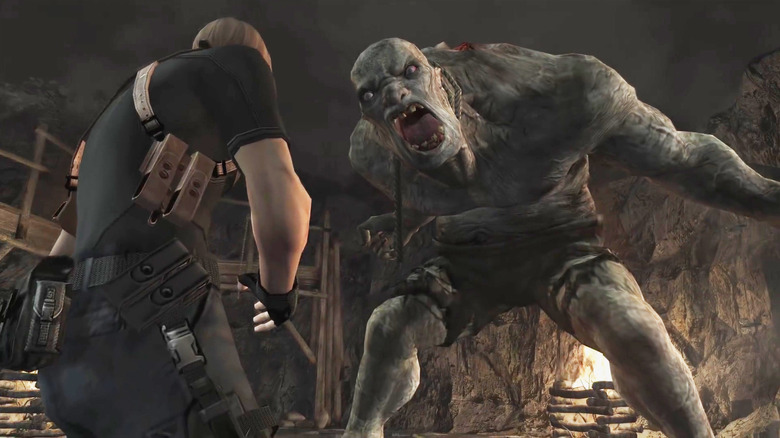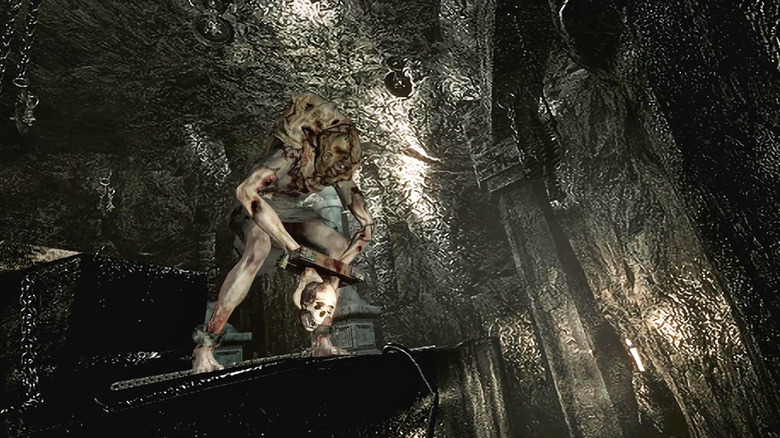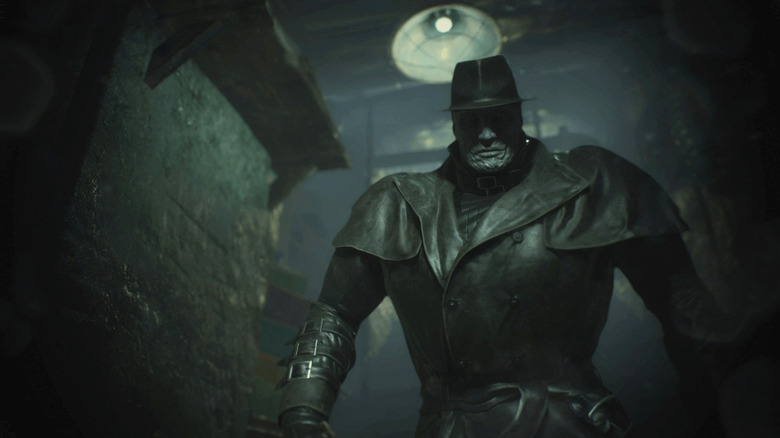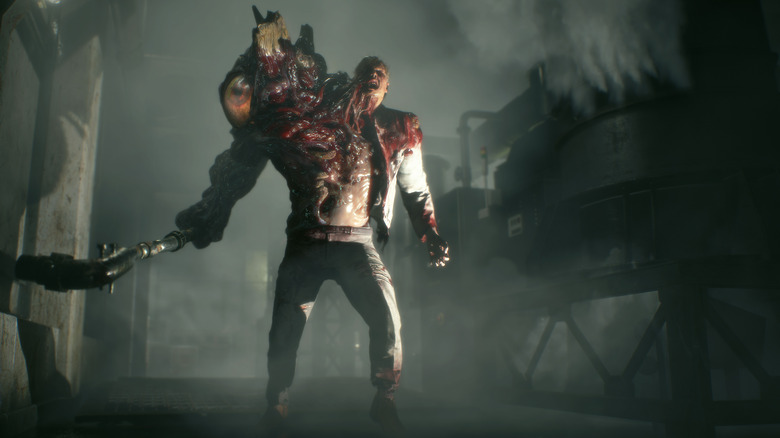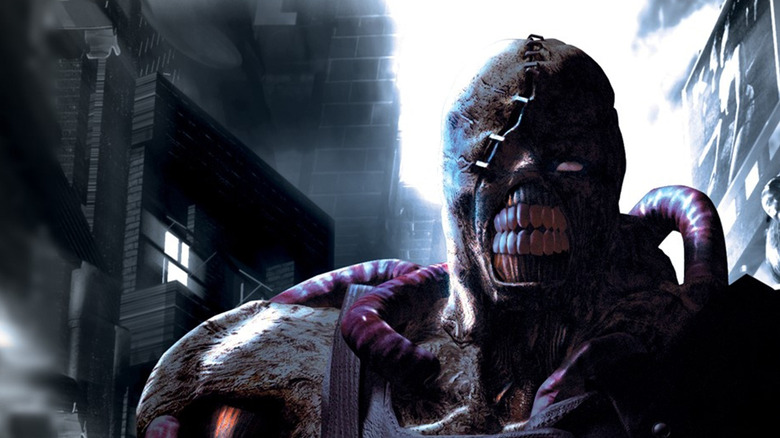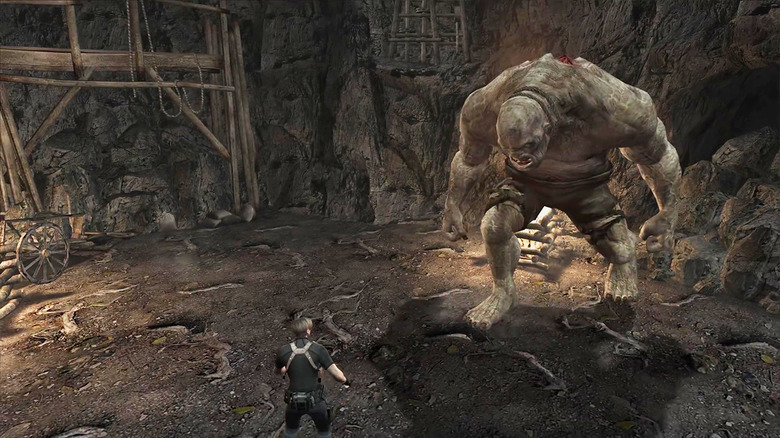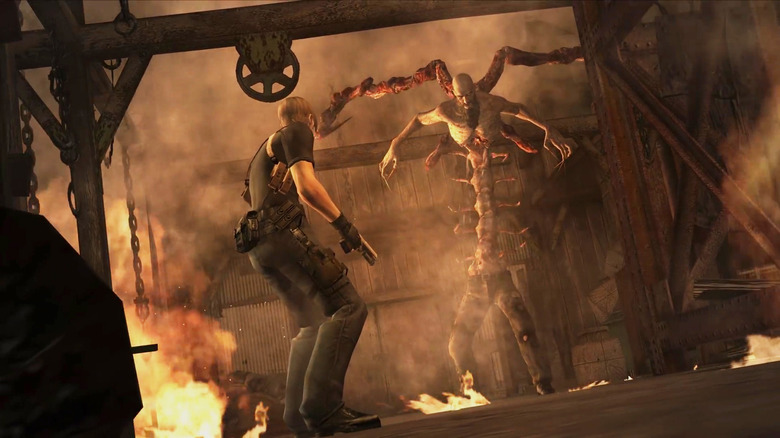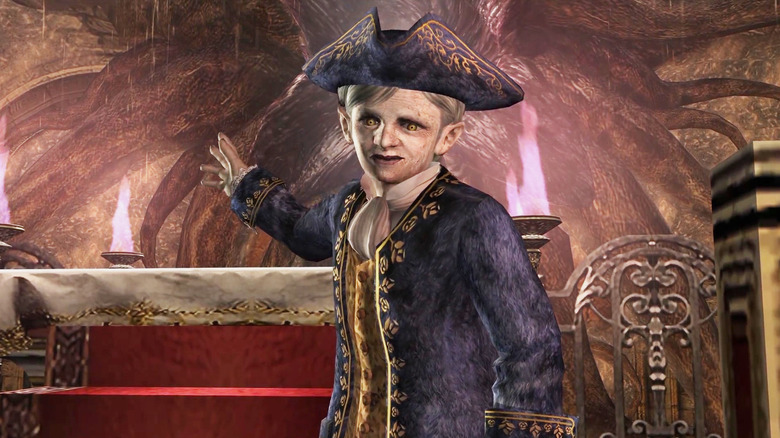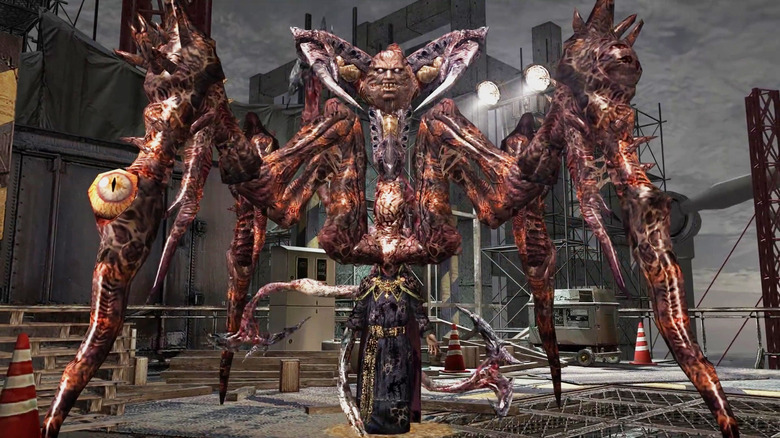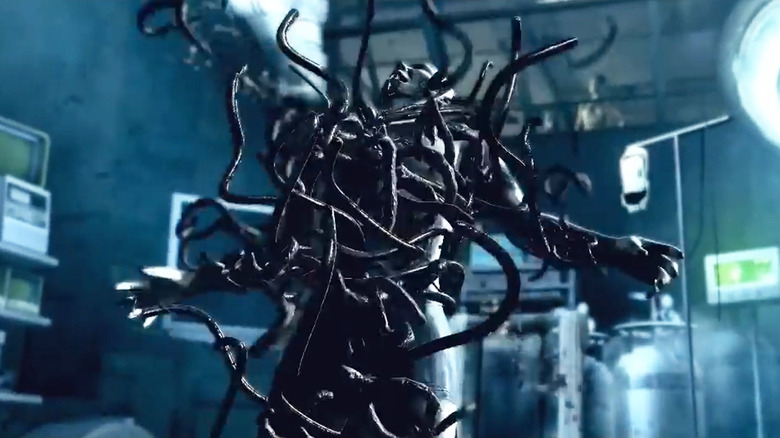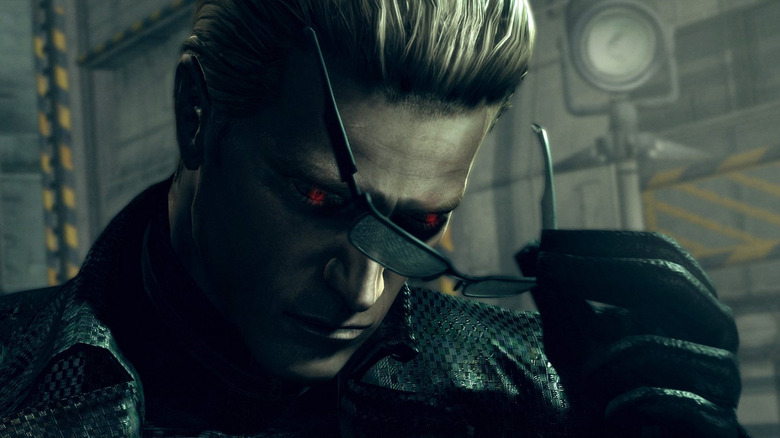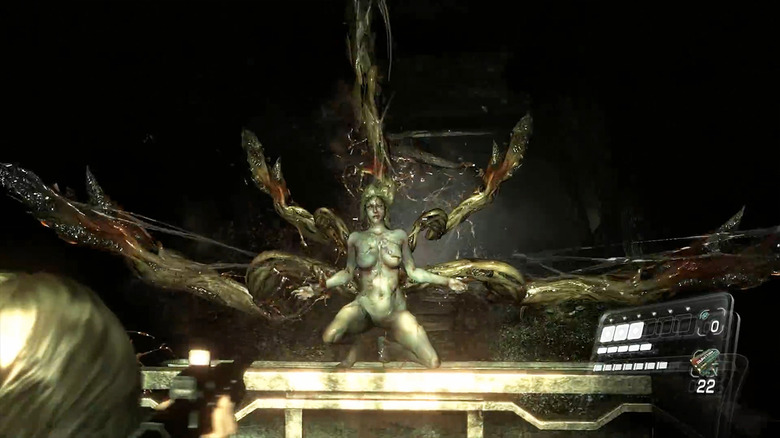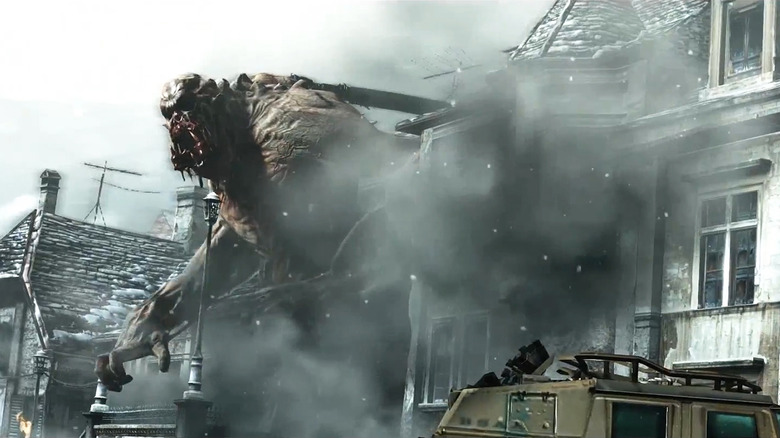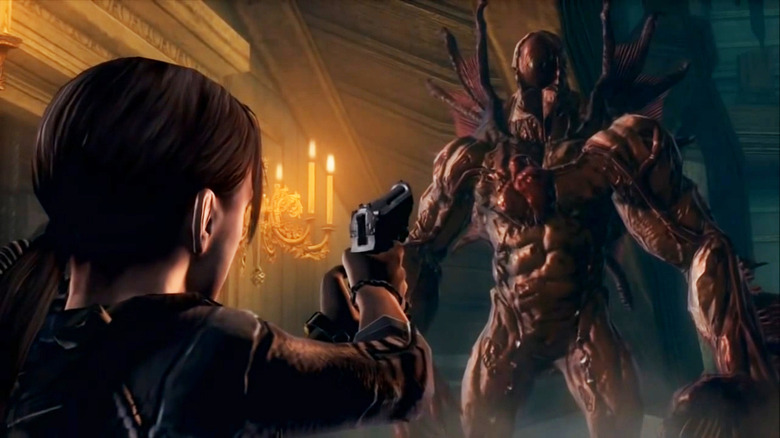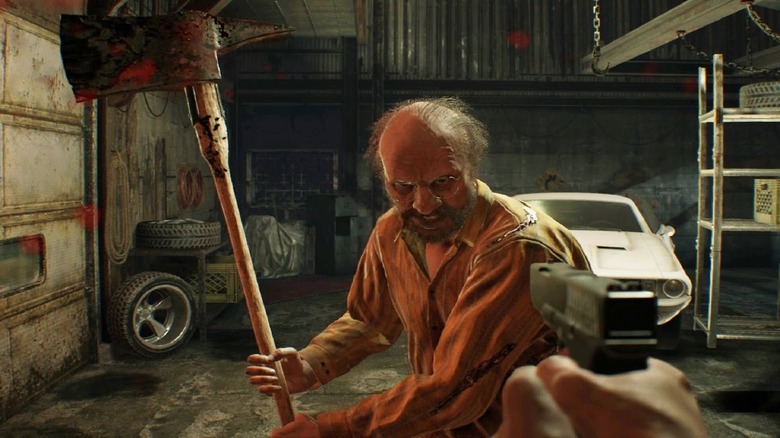The Best Resident Evil Bosses In Franchise History
Ever since it shambled onto PlayStations in the mid '90s, Capcom's Resident Evil franchise has continued to capture the hearts and minds of fans the world over. Something about the series' grotesque hybrid of sci-fi and survival horror makes the allure of each new installment irresistible to loyal enthusiasts; and there's no doubting that Resident Evil's deep roster of aberrant and undead enemies are a huge part of that enduring appeal.
Capcom identifies Resident Evil 2 as the turning point: "The 1998 original was hailed as a gaming masterpiece [that] propelled Resident Evil into mainstream pop culture and the entertainment you know today." Indeed, RE2 cranked up the dial on many of the hallmarks that made the first Resident Evil so memorable, including a cinematic emphasis on its all-star lineup of unique (and persistent) boss battles — a trope that subsequent Resident Evil titles have sustained wholeheartedly to this day. So, keep those healing herbs on-hand, because we're about to take a close look at the best Resident Evil bosses in franchise history.
Lisa Trevor is Resident Evil's missing link
While she didn't appear in the original 1996 PlayStation release of Resident Evil, Lisa Trevor was first introduced to audiences via the 2002 GameCube remake. This mutated hunchbacked monstrosity is the daughter of famed architect George Trevor — designer of the Arklay Research Facility — who was abandoned to her grisly fate after exposure to multiple rounds of early B-Virus testing. Additional lore also reveals that Lisa Trevor's particular genetic cocktail would eventually become a primary source of the dreaded Golgotha virus of Resident Evil 2.
If Lisa Trevor's superhuman strength and uncanny regenerative abilities don't slow you down, the extra skin draped across her horrible face might catch you by surprise. That's right: Lisa wears her dead mom's face. And when considering the extreme creature feature horror of subsequent Resident Evil releases, it's not too difficult to imagine why Capcom would want to retcon a little more of that bombastic storytelling into their eagerly anticipated special edition.
Mr. X is the coolest tyrant to stalk the streets
When it comes to Resident Evil bosses, none is perhaps more iconic than the big bad of the original game: the Tyrant. But it wasn't until the release of Resident Evil 2 and beyond that the Tyrant would earn its way into our hearts by way of a truly memorable series of encounters.
The Tyrant of RE2 (as codified in the 2019 remake) is known as Mr. X (aka T-00) and is presented to players as a silent, stoic, nigh-unstoppable enemy who thwarts their progression time and time again. The Resident Evil Archives from BradyGames describes RE2's Tyrant as "an improved version of the first game's T-002 type" with "better intelligence and recovery ability than its predecessor." Unsurprisingly, those mechanical strides were echoed by RE2's narrative development, which took the Umbrella Corporation's sordid story from the rural confines of the Arklay Research Facility into the calamitous world at large.
What followed were a series of Tyrants, each more formidable than the ones that came before. But it's Mr. X from the RE2 remake — with his cool trenchcoat and killer stride — that stands out as our favorite incarnation of the infamous arch-enemy.
William Birkin puts the "g" in "grotesque"
One of the most satisfyingly gruesome bosses in Resident Evil history is our old pal William Birkin, the primary antagonist of Resident Evil 2. This head of the Golgotha Virus research project undergoes a series of grotesque mutations throughout the course of RE2 after exposing himself to the G-Virus. And, eventually, the player is confronted by the odious doctor during the game's spectacular finale.
Players get to witness a few of Birkin's hideous transformations throughout the game: two as Leon flees the research facility, and a fourth stage of mutation after Claire gets the train online during the self-destruct sequence. Later, once Leon is united with Claire and Sherry, we're treated to a teaser of a fifth and final iteration of G when a large, amorphous form attempts to rip through a subway car door moments before we cut to black.
Birkin is also the key to RE2's true ending, which you can unlock by completing a second playthrough of the game in 2nd Run mode. During the 2nd Run finale, you'll encounter Birkin's fifth stage form: an oversized, amorphous mass of tentacles, teeth, and eyes. After all: in the world of Resident Evil, with great power comes great deformity.
Nemesis is the most dedicated B.O.W. on the beat
Despite his physical similarities to Resident Evil's ineffable Tyrant, the eponymous Nemesis of Resident Evil 3: Nemesis gets by on his own steam and is easily one of the more fondly remembered enemies in the Resident Evil roster. Like William Birkin before him, Nemesis is encountered several times throughout RE3 in various stages of baleful mutation, growing more powerful with each successive battle.
Per the "Nemesis T-Type (Pursuer) Notes" found in Resident Evil: The Umbrella Chronicles, Nemesis "is the result of combining a Nemesis parasite with a host Tyrant body," and "its improved intelligence gives it the capacity to follow orders as well as the ability to operate a variety of weaponry." Furthermore, "the regenerative powers of the Nemesis T-type were incredible... [Its] new forms and their abilities are completely unpredictable."
After his shenanigans in the Resident Evil series, Nemesis T-Type went on to become a fan-favorite player character in the arcade fighting games Ultimate Marvel vs Capcom 3 and Marvel vs Capcom: Infinite. This version of Nemesis is a little softer on the eyes, but no less deadly — and has no doubt introduced a whole new wave of video game fans to Racoon City's classic saga of survival horror.
El Gigante is the pride of Los Iluminados
The hulking Bio-Organic Weapons (B.O.W.) from Resident Evil 4 known as El Gigantes are fearsome monstrosities that serve as bosses and minibosses throughout Leon Kennedy's war against Los Iluminados, the militant religious sect behind the spread of the deadly Plaga parasite.
You can encounter El Gigante four times throughout the course of Resident Evil 4, but the first run-in with this massive brute is usually the most deadly. To take him down, you'll need to do enough damage to force the Plaga parasite lodged around El Gigante's spine to reveal itself — no small feat if you're lacking an appropriate amount of firepower. The result is one harrowing (and often deadly) confrontation.
El Gigante has a number of spiritual successors in the series: it made a return of sorts in Resident Evil 5 as Ndesu, a B.O.W. created using a number of smaller Type-2 Plagas along with the larger specimen; and there's no doubting that the Ogroman of Resident Evil 6 is a relative of colossal proportions. But, no matter how many El Gigante clones make their way into Resident Evil's sordid saga, none will outshine the original big boy from RE4.
Father Mendez fights fire with fire
With his towering gait and drabby longcoat, Father Bitores Mendez of Resident Evil 4 resembles something of an analog to RE2's T-00 and its predecessors. But that similarity is purely cosmetic, considering the pivotal role Mendez plays as a community leader within Los Illuminados. Mendez is more than a mere bruiser — but that doesn't mean he won't send you home screaming when all hell breaks loose.
Once you finally come face-to-face with Mendez, you'll have to fight his mutated form within the confines of a locked and burning building. During the Father's grim transformation, his fingernails become needles, four clawed arms sprout from his shoulders, and his freakishly elongated spine grows an array of articulated, claw-like appendages. If this abhorrent description conjures up images of some infernal centipede, it's not too far from the truth.
On top of Mendez' impeccable character design, the battlefield is what sets this fight apart from the rest. As the building burns and Mendez falls apart along with it, his hooked torso will swing itself to and fro when he follows you through the smoke and cinders — resulting in one deliciously horrible and action-packed boss battle if ever there was one.
Salazar holds the keys to the unholy kingdom
The castellan known as Ramon Salazar was a high-ranking official in Osmund Saddler's Los Iluminados cult and is well known by Resident Evil fans as the true enabler of the Plaga infestation that kickstarted the woeful events of Resident Evil 4. After all, Salazar's ancestral castle is where Saddler found the long-dormant remains of the Plagas; according to the account detailed in Lius' Memo 2, "When Salazar and his men excavated the remains, it almost appeared as if the Las Plagas were just waiting to be discovered so that they could resurrect."
Salazar makes the cut as one of the best Resident Evil bosses in franchise history because he embodies a wide swathe of classic horror tropes in one vile, mutagenic package. The gothic horror stylings of Resident Evil 4 are gloriously embellished by the diminutive castellan's station, including his looks, his lair, even his way of speaking. But the real magic happens during the last encounter with Salazar, when he merges with the Queen Plaga (along with one of his Verdugo henchmen) into an epically grotesque Plaga hybrid of prodigious size and power. Truly, Phase 2 Salazar is one hideously amorphous monster that could make even John Carpenter jealous.
Osmund Saddler is the big bad evil guy of your dreams
PlayStation Magazine called Resident Evil 4 "a major milestone in gaming history," and Gamer.tv said that "playing Resident Evil 4 is like reading an utterly compelling horror novel," going so far to label it "survival horror's most glorious moment." A lot of that glory comes from the peculiar alchemy that RE4 conjures up, from the game's gothic Western European locales to its esoteric exploration of eldritch horror. And very little in the game is as esoteric or eldritch as its big bad evil guy: Osmund Saddler.
As the founder of Los Illuminados, Saddler was ultimately responsible for the revival of the Plaga infestation (following his successful indoctrination of castellan Salazar). And the ultimate form this messianic madman takes during his final battle is truly one of the Resident Evil franchise's most satisfying feats of cinematic monstrosity. After the Plaga parasite takes hold, several enormous appendages sprout from Saddler's head, along with an array of barbed tentacles upon his arms and back. The resulting monstrosity looks like something straight out of the darkest corners of the Cthulhu mythos and endures as one of the most compelling villains in the storied history of Capcom's beloved series.
Uroboros Mkono is a monster's monster
Kotaku said Resident Evil 5 "delivers a riveting and intense experience well worth the time spent playing it," while GameSpot called it "a fun and frantic evolution of RE4's breakthrough gameplay and the series' horror themes." Among other notions, those horrific themes explore the unchecked evils of opportunism and the unbridled chaos of evolution — ideas both exemplified to a T by RE5's Uroboros enemy.
The twisting, amorphous mutant known as Uroboros is a creation of Albert Wesker and his cronies encountered more than once as you explore Kijuju and its surrounding environs. The main iteration — Uroboros Mkono — is encountered in Chapter 5-2 when you investigate the Uroboros Research Facility. A horrible, wriggling monstrosity that would give H.P. Lovecraft the heebie jeebies, Uroboros Mkono is bar none one of the coolest bosses Capcom ever offered up for their survival horror franchise.
It's no surprise that this inky behemoth is vulnerable to fire, and you'll have to expertly utilize your environment during your encounter with Uroboros in the research facility to make it out alive. Of course, this isn't the last mutant in RE5 to bear the Uroboros name — Uroboros Aheri, the bigger and better mutated form of villainess Excella Gionne, awaits you closer towards the climactic endgame.
Albert Wekser is the archenemy you love to hate
The erstwhile antihero known as Albert Wesker is such a ubiquitous agent of change throughout the entire Resident Evil saga that it's hard to pinpoint his best appearance. But some of the most memorable include his surprise boss battles in Resident Evil 5 against heroes Chris Redfield and Sheva Alomar.
Wesker's meddlings throughout the Resident Evil saga led to his eventual role as architect of the Uroboros virus that dominates the plot of Resident Evil 5 (along with a few new strains of RE4's Plaga virus). You'll encounter Wesker three times throughout RE5, including his team-up boss battle at the Spencer Estate featuring a corrupted Jill Valentine, a cinematic run-in at the Tricell hanger, and his epic endgame battle within the lava-strewn crater of a volcano.
The Wesker fights of Resident Evil 5 are testaments to the same genre-bending ingenuity that pervades Resident Evil 2 and other high-water marks of the series. One is an ultimate challenge of marksmanship, another will put your timing to the test, the last is a pulse-pounding action scene for the ages. And all of them are pure Resident Evil fun in the radical tradition that made the series great to begin with.
Deborah Harper has all the right moves
Horror comes home when Helena Harper makes a breathtaking discovery about what happened to her sister Deborah during the events of Resident Evil 6 — and her battle beside Leon against a mutated Deborah deep beneath the catacombs of the Tall Oaks Church is a series classic. As the story goes, Derek Simmons kidnapped Deborah Harper to use her for The Family's C-Virus experiments.
Her official case file confirms that Deborah "had been turned into a hideous creature with no semblance of the humanity she once had other than the gentle facial features that hint at her former beauty." Because, despite orders to terminate her, one unidentified Family member desired to "keep her around and see how she takes to the C-Virus."
Deborah's gruesome mutation via the Chrysalid Virus resulted in her development of preternatural strength and agility, a slimy protective epidermis, and an assortment of prodigiously large clawed appendages that she could use for direct attacks and to ascend the rickety catacomb substructures. At the end of the day, with its spiraling scale, relentless action, and keen sense of narrative gravitas, the battle against Deborah Harper is the stuff Resident Evil legends are made of.
Ogroman offers players an extra-large dose of dread
In the tradition of RE4's El Gigante and its successor in RE5, Ogroman from Resident Evil 6 is a terrifyingly titanic B.O.W. (or Bio-Organic Weapon) and is one of the largest enemies in Resident Evil history. Even though enemies like Yawn, Plant 42, and U-8 tower over players in their own right, the Ogroman fight in RE6 presents an epic sense of scale that was previously unseen in Resident Evil titles before it crashed its way into the events of the Edonian civil war. This gargantuan bundle of joy made its monstrous debut on Christmas Eve in 2012 of the Resident Evil timeline; and, like most of the enemies in RE6, the oversized Ogroman is the product of the dreaded Chrysalis Virus.
As far as boss battles go, Ogroman isn't exactly the toughest bad guy to beat — just unload a handy supply of heavy weapons into the dutifully exposed areas of tender, membranous flesh and voilà. But the unrivaled scale and action-packed blockbuster presentation of this colossal B.O.W. make it hands down one of the most memorable encounters in the series.
Dr. Jack Norman is the Abyss that stares back
The majority of Resident Evil baddies are perversions of science, with abilities rooted in sci-fi extrapolations of extreme body horror. Jack Norman, aka The Ultimate Abyss, however, is (seemingly) rife with supernatural elements that set it apart from similar encounters in the series.
Founder of the international terrorist organization Il Veltro, Dr. Jack Norman serves as the final boss battle of Resident Evil: Revelations, the 2012 franchise spinoff developed for the Nintendo 3DS handheld console. Set between the events of RE4 and RE5, Revelations tells the story of the early days of the BSAA; and the final climactic battle with Jack Norman puts players face-to-face with the catastrophic endgame of the t-Abyss Virus.
In his monstrous "Ultimate Abyss" form, the emotionally-tortured but freshly-mutated Dr. Norman is gifted with the ability to move blindingly fast — so fast that he appears to teleport and summon duplicate illusions of himself (a classic boss battle trope reminiscent of the final encounter with Ganon in The Legend of Zelda: A Link to the Past). Fortunately for us, this aquatic miscreant is no match for the swift moves and expert BSAA training of one Jill Valentine.
Jack Baker is totally committed to scaring you witless
Featuring a southern gothic aesthetic that's more akin to Toby Hooper's Texas Chainsaw Massacre than it is to the creature feature action of previous franchise titles, Resident Evil 7: Biohazard presents players with a grittier, more realistic take on the classic survival horror tropes of the series; its grim enemies adequately follow suit. Take Jack Baker, for instance: the coolest boss of RE7 and one of the most interesting bosses in the entire Resident Evil franchise.
Capcom has a long, distinguished history of humanizing their Resident Evil bosses; many of them are, in fact, the result of human genetic mutations gone horribly (and monstrously) wrong. Resident Evil 7 doubles down on this philosophy, and the terror that saturates the encounters with Jack Baker is so successfully frightening because Jack is so human in his actions. Ultimately, the twisted heart of this once-proud family man is no match for the infectious madness of Evelin's Mold. Driven by madness and simultaneously gifted with preternatural strength and repulsive regenerative powers, Jack Baker is no less than insidious.

